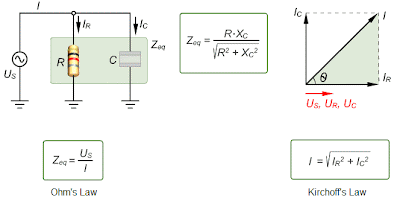Analysis of Series RC Circuit
Ohm's Law and Kirchoff's Law are used in the analysis of a series RC circuit. Ohm's Law, when applied to a series RC circuit, involves the use of quantities of Z, U, and I.
The three equivalent forms of Ohm's Law are shown above. From
Kirchoff's voltage law, the sum of the voltage drops equals the source
voltage (Us). Since UR and UC are 90o out of phase, the magnitude of the source voltage is expressed by the voltage triangle as shown in the illustration.
Analysis of Parallel RC Circuit
The source voltage appears across both the resistive and the capacitive branches. Therefore, Us, UR and Uc
are all in phase and of the same magnitude. In a parallel circuit, each
branch has its individual current. The resistive branch current IR is in phase with Us, but the capacitive branch current Ic leads Us by 90o.
By Kirchoff's current law, the total current is the phasor sum of the
two branch currents. The impedance of a parallel circuit equals the
applied voltage divided by the total current Zeq = Us / I.









.gif)


No comments:
Post a Comment